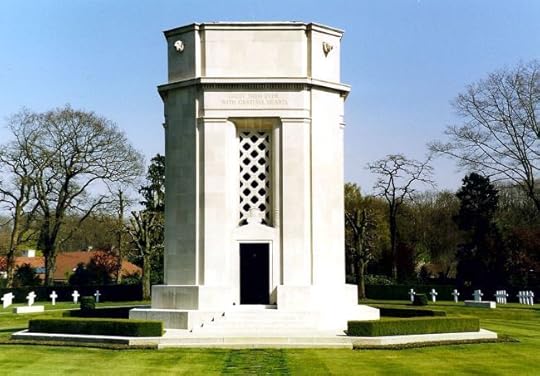Nick Metcalfe's Blog, page 16
July 24, 2014
President Obama, Flanders Fields American Cemetery, and an American with 36th (Ulster) Division.
The recent visit by President Obama to Flanders Fields American Cemetery and Memorial at Waregem in Belgium brought back memories of my own visit there a few years ago. The site of the cemetery is near where the US 91st Division attacked and captured the wooded area of Spitaals Bosschen. It is beautiful and it has a very different ‘feel’ to Commonwealth cemeteries. Well-spaced rows of white crosses surround the chapel, which stands in the centre of the six acre site. Inside the chapel, the altar and walls are marble and the furniture is of carved oak, stained to reflect the black altar. On either side are the Walls of the Missing, inscribed with the names of the 43 men whofell in Flanders and who sleep in unknown graves. Bodies of some of these men have been recovered since and identified; those names are marked with a rosette

I was working on Blacker’s Boys, the history of the 9th (North Irish Horse) Battalion, Princes Victoria’s (Royal Irish Fusiliers), and, after months of research, I had identified that one of the Battalion’s officers was commemorated in the memorial chapel. The man I was looking for—Lieutenant Harold Sydney (Syd) Morgan, United States Army Medical Reserve Corps—was killed in action almost exactly 96 years ago.
Syd Morgan was born on 2 May 1890 at Winton, Pennsylvania to Welsh and English parents. He studied at Stanford University School of Medicine, Palo Alto, California until 1912 (Phi Delta Theta) and at Johns Hopkins University School of Medicine, Baltimore, from which he graduated as a doctor in 1915. He practised at Bellview Hospital, New York. Following the entry of the United States into the war, he was commissioned as a Lieutenant on 9 August 1917 into the United States Army Medical Reserve Corps in New York. He arrived in France soon afterwards, posted first to United States Army Base Hospital Number 2 at Etretat before being posted to 36th (Ulster) Division in the British Expeditionary Force. This was a common practice; in order to provide the greatest experience to the medical officers of the American Expeditionary Force they were attached to British and Commonwealth hospitals and field ambulances, and as unit medical officers. The first American unit to arrive in France, in May 1917, was a base hospital and the first American casualty, in July 1917, was a medical officer. This article Yanks In The King’s Forces is worth reading and contains excellent photographs.

Morgan spent a short period with one of the Ulster Division’s field ambulances before joining the 9th Royal Irish Fusiliers in 108th Brigade as the medical officer in February 1918. On 19 March he wrote to another American medical officer, with whom he had served before joining the 9th Royal Irish Fusiliers:
As it happens, I am still with the worthy 9th, in reserve right now at Grand Seracourt (sic). Our tours in the line have been simple enough lately and casualties rare. It has been good sport, however, for the weather recently has been absolutely perfect, giving wonderful observation. I’ve seen plenty of Boche and have missed his machine-gun bullets successfully. One night the C.O. and I went all around the line about twelve o’clock, going out into the saps and wandering about in No-man’s Land. Incidentally a machine-gun turned near us and d___ near cut the grass between our legs. The Boche is quiet these days, however, and he hardly replies at all to the rather heavy strafing he gets night andd ay. One thing certain now is our guns are not afraid to speak. The best sight I have seen recently was watching the tremendous shell of a 12-inch howitzer flying off into space. It is very remarkable how one can see the shell for fully a minute or two from the moment it leaves the muzzle until it goes out of view.
The ‘Boche’ were not quiet for much longer. On 21 March 1918 the German offensive swept all before it and 36th (Ulster) Division fought a withdrawal action over a period of seven days from St Quentin to Erches. For his gallantry during this period Syd Morgan was awarded the Military Cross—one of 173 such awards to medical officers from the United States. His citation stated:
For conspicuous gallantry and devotion to duty during the retirement from Grand Seraucourt on the morning of March 22nd. This officer was retiring behind the rearguard, and on approaching Artemps was told that some wounded were still lying in Grand Seraucourt. Although he knew that the enemy was already on the outskirts of the village he returned at once with some stretcher bearers and succeeded in bringing out the wounded. He thus at the commencement of the operations set a splendid example to his stretcher bearers of devotion and courage.
Having been withdrawn from the line on the night of 27 March, 108th Brigade was detached from the Ulster Division and ordered to a position south of Ypres near Wulverghem. During the second phase of the German offensive, the men of the 9th Royal Irish Fusiliers were again in the thick of the fighting. During the attacks and counter-attacks near Wulverghem on 12 April 1918 Morgan was tending to the wounded with two stretcher-bearers when he was hit on the leg. As he was being placed on a stretcher a shell killed him. He was buried nearby.
There is some evidence to indicate that his body was exhumed and taken to Flanders Fields American Cemetery during the period of cemetery concentration after the war, but positive identification proved impossible. He is commemorated in the Flanders Fields Memorial Chapel and also on the City of San Diego and San Diego County Memorial Roll.
 Lieutenant Harold Sydney Morgan MC United States Army Medical Reserve Corps
Lieutenant Harold Sydney Morgan MC United States Army Medical Reserve Corps



